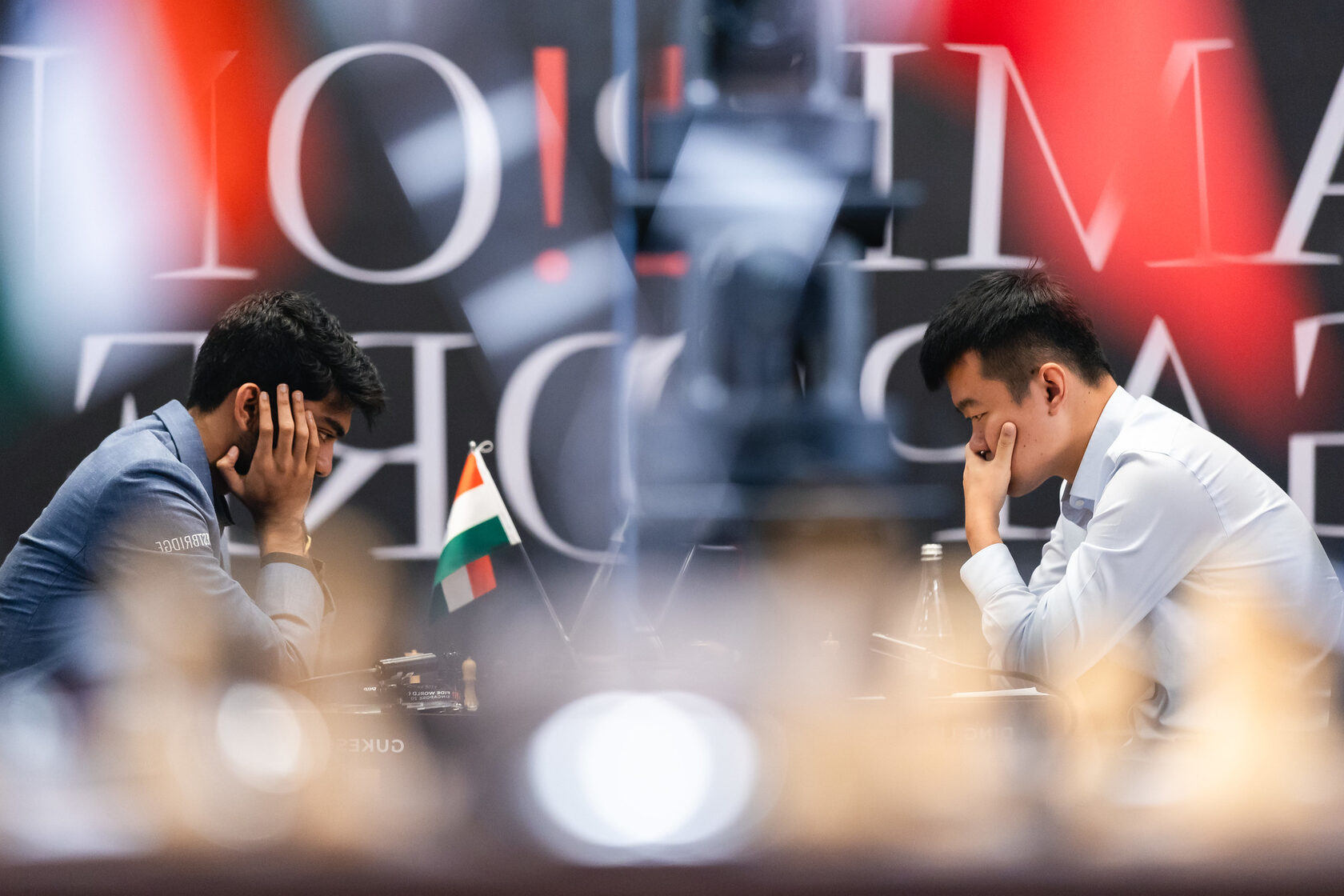The second game of the FIDE World Championship between Ding Liren and Gukesh D ended in a solid draw. Both players decided to play it safe, steering clear of major complications and avoiding any risks. After a series of exchanges, a draw was agreed by threefold repetition on move 23. This result seems to satisfy both players.
Today's ceremonial first move featured two local celebrities. Ten-time Singapore champion and a living legend of Singapore chess, Mr. Tan Lian Ann, opened with the white pieces. Among many other achievements, Tan Lian Ann represented Singapore in four Olympiads, with three of them on board one.
Today's ceremonial first move featured two local celebrities. Ten-time Singapore champion and a living legend of Singapore chess, Mr. Tan Lian Ann, opened with the white pieces. Among many other achievements, Tan Lian Ann represented Singapore in four Olympiads, with three of them on board one.
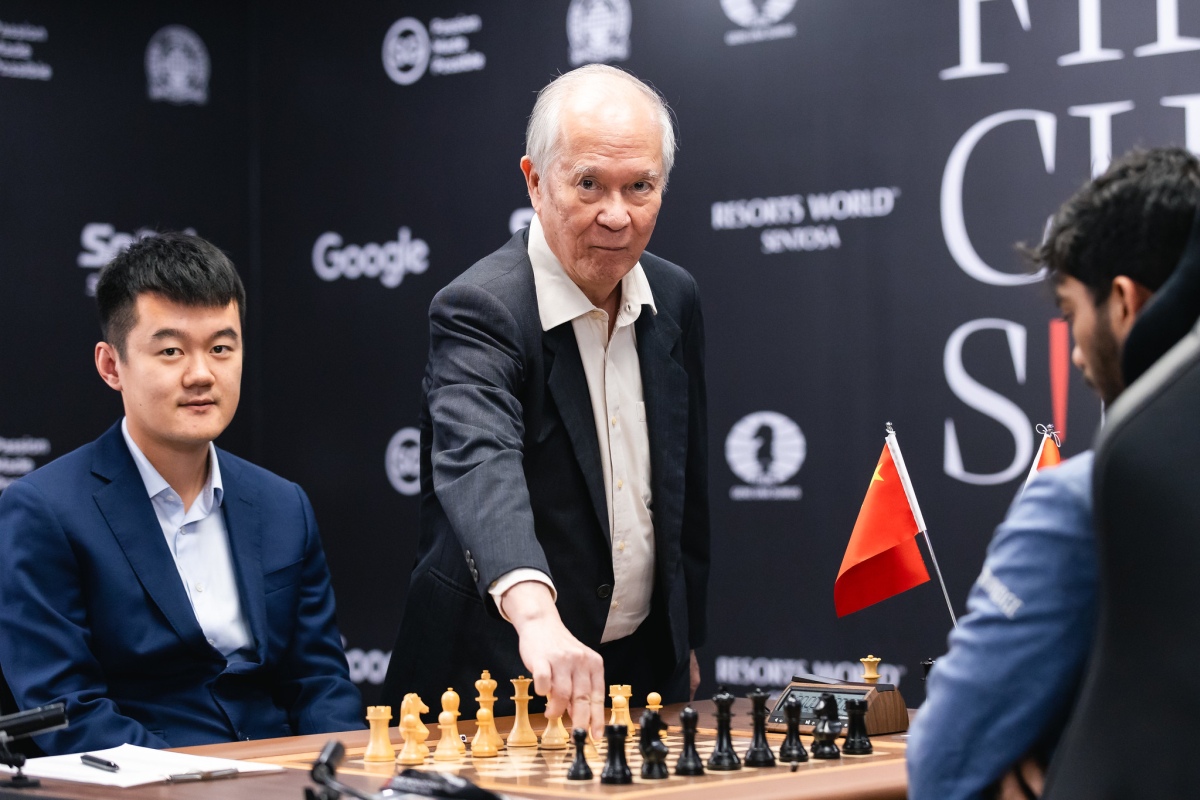
For the black pieces, the move was performed by Professor Lim Kok Ann, widely known as the founder of Singapore chess. A famous microbiologist, he was Singapore's first National Chess Champion, and for close to five years, he was instrumental in fostering many Singaporean chess masters. Having passed away, he was represented by his daughter Stella Kon, a renowned Singaporean playwright, novelist, short-story writer, and poet. She and her siblings have also sponsored the latest GM tournament in Singapore.
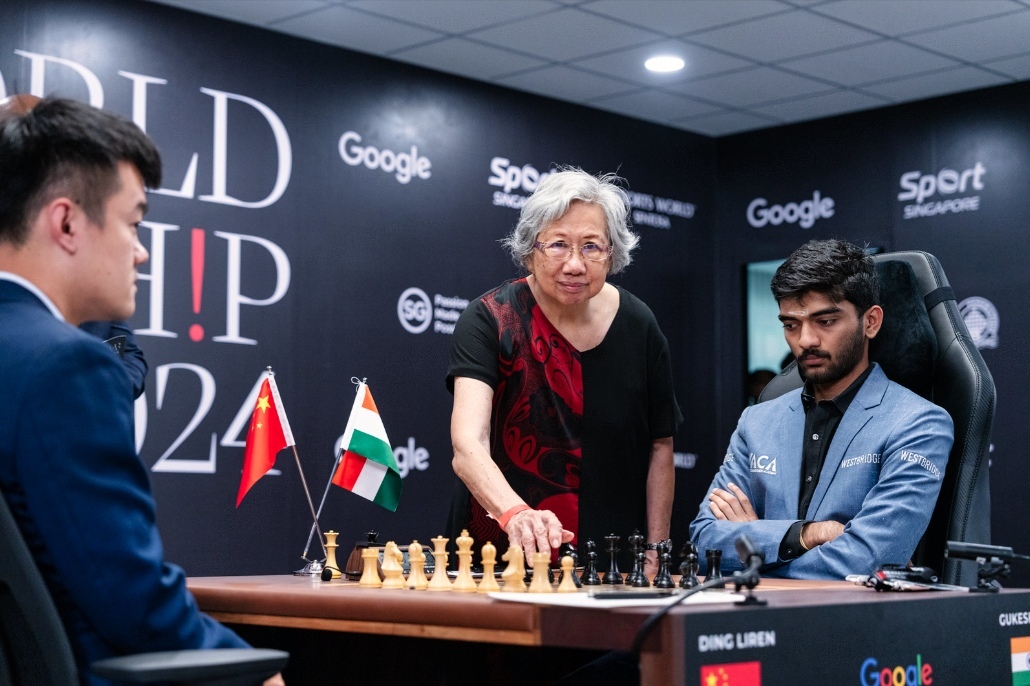
Ding Liren's first move 1.e4 surprised resident match commentator GM David Howell. "I am a bit shocked by his opening choice. He rarely employs the king's pawn openings until the last few months, when he has been experimenting a bit with it - he doesn't seem like a natural e4 player to me, but here we are!"
Gukesh took a moment to reconsider his strategy when Ding Liren played 5.Nc3 – the Giuoco Pianissimo variation of the Italian Opening. The Chinese champion had never played this line before, always choosing more dynamic setups with 5.c3. His most recent example was earlier this year in the Sinquefield Cup against … Gukesh!
"My basic idea was to play carefully, and I was fine with a draw. I remembered that my second said that the opening was 0.2 according to the computer, so I may have missed some opportunities," said Ding, initially content with his approach.
Gukesh took a moment to reconsider his strategy when Ding Liren played 5.Nc3 – the Giuoco Pianissimo variation of the Italian Opening. The Chinese champion had never played this line before, always choosing more dynamic setups with 5.c3. His most recent example was earlier this year in the Sinquefield Cup against … Gukesh!
"My basic idea was to play carefully, and I was fine with a draw. I remembered that my second said that the opening was 0.2 according to the computer, so I may have missed some opportunities," said Ding, initially content with his approach.
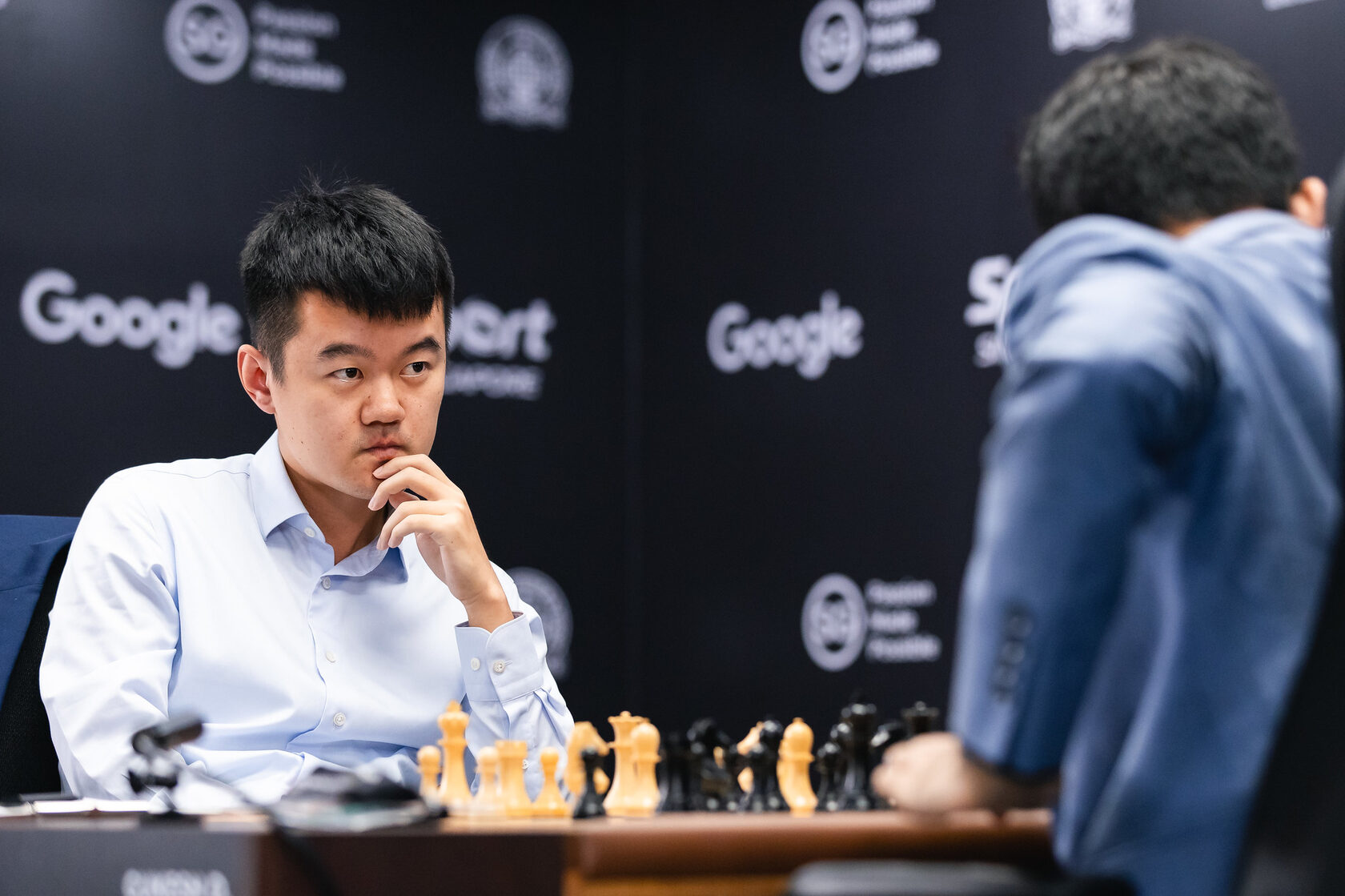
The theoretical novelty of today's game was 9.a5, grabbing more space on the queenside. Funnily enough, another top Indian player, Praggnanandhaa R, was involved in the two elite games in this line: in those games, played in 2023, the chosen moves were 9.Bxe6 and 9.Bxc5
Gukesh was fine with this approach. "I just wanted to play a good game," he said. "With Black, so early in a match, you don't want to do anything stupid. Yesterday, I was feeling good; I was fresh and confident, just that I missed a few tactics, which can happen to anyone at any time."
Gukesh was on top of his game. He pondered over the position between moves nine and thirteen for about twenty minutes, eventually finding a very logical sequence of exchanges. The resulting endgame looked totally equal.
Gukesh was fine with this approach. "I just wanted to play a good game," he said. "With Black, so early in a match, you don't want to do anything stupid. Yesterday, I was feeling good; I was fresh and confident, just that I missed a few tactics, which can happen to anyone at any time."
Gukesh was on top of his game. He pondered over the position between moves nine and thirteen for about twenty minutes, eventually finding a very logical sequence of exchanges. The resulting endgame looked totally equal.
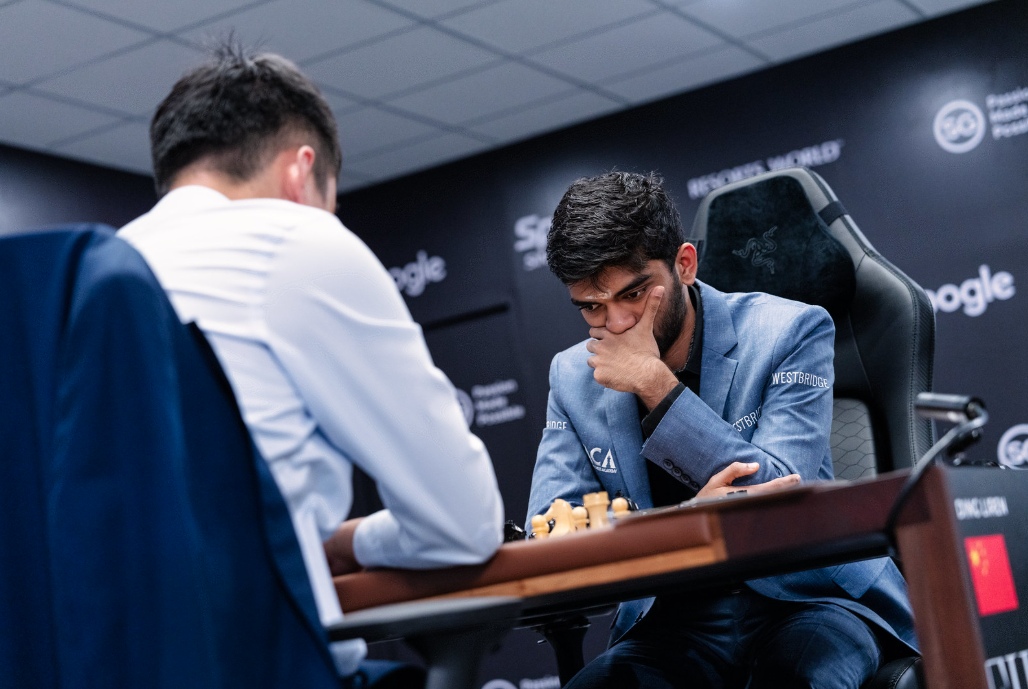
Contrary to what happened in the first game, Gukesh was fully concentrated at the board while Ding Liren was the one to take a couple of brief disappearances to their personal resting rooms – the tables had turned.
In the commentary booth, former World Championship challenger GM Boris Gelfand was asked which side he would choose. "If I had to choose sides, I would choose White. It's a slow game, and we can improve our pieces slowly. Black has difficulties in choosing what to do".
In the commentary booth, former World Championship challenger GM Boris Gelfand was asked which side he would choose. "If I had to choose sides, I would choose White. It's a slow game, and we can improve our pieces slowly. Black has difficulties in choosing what to do".

However, Ding's 14.Rdc1 came as a shocker. It's very rare to see a player abandon an open file with no apparent reason. On the commentary, GM Howell was sure that Ding Liren was still in preparation: "He has definitely seen this position before, sliding the rook across. You don't play rook to c1 within a few minutes if you haven't studied it before!"
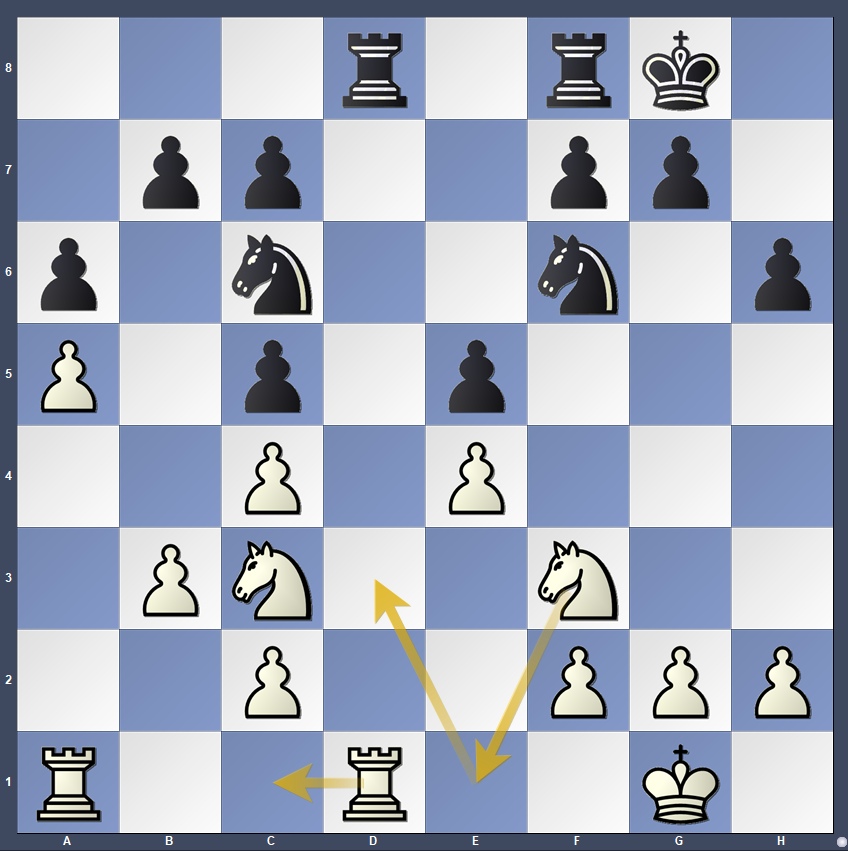
The ideas behind the mysterious move were quite hidden, and Gukesh took more than twenty-five minutes to sort things out. Ding Liren prophylactically defends the c2-pawn, which will come under attack at some point, avoiding the exchange of rooks at the same time.
Additionally, his king can move towards the center, and the knight on f3 can be transferred via e1 to d3 - an active position eyeing black's pawn weaknesses and blocking the d-file. A fantastic idea!!
That being said, it soon became clear that his plan had backfired. "The move Rc1 is a typical idea in this kind of structure, but I don't think it's a good move in the game because I didn't know how to develop while he has such a strong knight on d4. In fact, later on, I moved the rook back to d1," Ding lamented after the game.
Additionally, his king can move towards the center, and the knight on f3 can be transferred via e1 to d3 - an active position eyeing black's pawn weaknesses and blocking the d-file. A fantastic idea!!
That being said, it soon became clear that his plan had backfired. "The move Rc1 is a typical idea in this kind of structure, but I don't think it's a good move in the game because I didn't know how to develop while he has such a strong knight on d4. In fact, later on, I moved the rook back to d1," Ding lamented after the game.

In contrast, Gukesh D was quite happy: "I was able to find a good formation of pieces, after which it's hard for White to really make progress. Maybe his move 14.Rd-c1 was not the best, but I didn't see any other challenges in the position. Today was a good day, and hopefully, we will have many more good days coming."

Midway through the game, the many tens of thousands of viewers on FIDE's YouTube channel enjoyed the insights of the five-time World Champion Vishy Anand, who is also one of Gukesh's mentors. "We are actually neighbors in Chennai, as we live very near each other. Of course, if Gukesh wins the match, it will be huge for Indian chess. Many people would take up the game and start following. The fact that he is so young means that we can look forward to having him for a while – he would be the youngest ever in history."

Although the World Championship is the main event, the local organizers, along with FIDE, have programmed a wide range of side events for all the fans coming to Sentosa for the match. This afternoon, Google DeepMind scientist Nenad Tomašev delivered an exclusive presentation on the development and impact of AlphaZero, an AI program that has mastered complex games like chess. The session shed light on the intersection of technology and chess and offered unique perspectives for all enthusiasts.
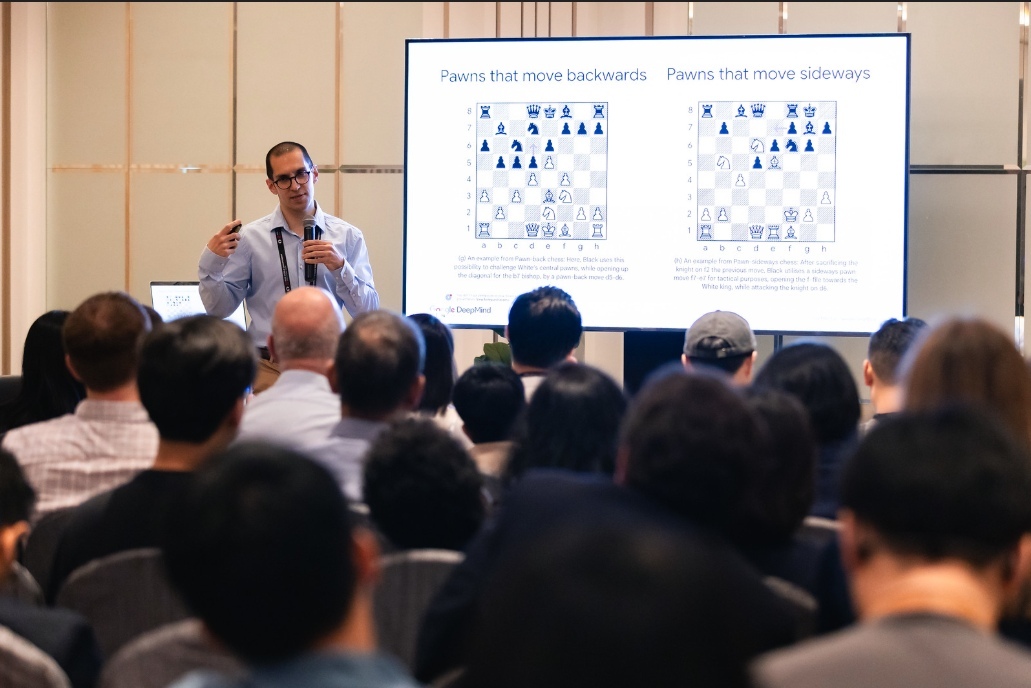
The third game of the match is scheduled for November 27, at 5 PM local time in Singapore, with Gukesh D playing White.
FACT SHEET, Game 2, FIDE World Championship:
White: Ding Liren
Black: Gukesh D
Result: ½-½
Game length: 23 moves
Opening: Italian Opening
Variation: Giuoco Pianissimo
Match score: 1½-½ (in favour of Ding Liren)
A batch of photos from the game is available at
flickr.com/photos/fide/albums/72177720322177131/
Written by IM Michael Rahal (Singapore)
Photos: Eng Chin An and Maria Emelianova
About the event
Current World Champion Ding Liren, representing China, and challenger Gukesh D, from India, will face each other in a fourteen-game classical chess match. The player who scores 7.5 points or more will win the match, picking up the better part of the $2.5 million total prize fund.
The first of the fourteen scheduled games will take place on Monday, November 25 at 5 pm. Gukesh will open with White. The match will be hosted at the luxurious Resorts World Sentosa and will be broadcasted live with expert commentary on the FIDE YouTube Channel.
FACT SHEET, Game 2, FIDE World Championship:
White: Ding Liren
Black: Gukesh D
Result: ½-½
Game length: 23 moves
Opening: Italian Opening
Variation: Giuoco Pianissimo
Match score: 1½-½ (in favour of Ding Liren)
A batch of photos from the game is available at
flickr.com/photos/fide/albums/72177720322177131/
Written by IM Michael Rahal (Singapore)
Photos: Eng Chin An and Maria Emelianova
About the event
Current World Champion Ding Liren, representing China, and challenger Gukesh D, from India, will face each other in a fourteen-game classical chess match. The player who scores 7.5 points or more will win the match, picking up the better part of the $2.5 million total prize fund.
The first of the fourteen scheduled games will take place on Monday, November 25 at 5 pm. Gukesh will open with White. The match will be hosted at the luxurious Resorts World Sentosa and will be broadcasted live with expert commentary on the FIDE YouTube Channel.

